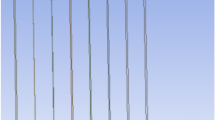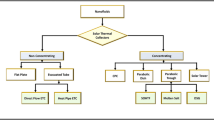Abstract
The performances of three types of solar collectors using various nanofluids are theoretically investigated; further, by varying the concentration of binary nanofluids comprising of two highly efficient nanofluids, the performances of the solar collectors are analytically examined. The results obtained demonstrate that MWCNT, CuO, and Fe3O4 nanofluids show a higher efficiency compared with other nanofluids. Both MWCNT/CuO and MWCNT/Fe3O4 binary nanofluids provide efficiency enhancements in the range 2–50 %, 3–7 %, and 2–4 %, respectively, in flat plate, vacuum U-tube, and heat pipe solar collectors, compared with a 0.05 vol% MWCNT nanofluid. The use of binary nanofluids enhances the efficiency of solar collectors, which further increases with the concentration of the binary nanofluids. Furthermore, when the MWCNT/CuO binary nanofluid shows a higher efficiency than the MWCNT/Fe3O4 binary nanofluid in three solar collectors.
Similar content being viewed by others
Abbreviations
- A :
-
Area (m2)
- C :
-
Conductance (W/m·K)
- Cp :
-
Specific heat capacity (J/kg·K)
- D :
-
Diameter (m)
- F :
-
Efficiency factor
- F’:
-
Solar collector efficiency factor
- f :
-
Friction factor
- FR :
-
Collector heat removal factor
- FPSC :
-
Flat plate solar collector
- HPSC :
-
Heat pipe solar collector
- G :
-
Solar radiation (W/m2)
- h :
-
Heat transfer coefficient (W/m2·K)
- k :
-
Thermal conductivity (W/m·K)
- L :
-
Length (m)
- m :
-
Mass flow rate (kg/s)
- Nc :
-
Number of glass cover
- Qu :
-
Useful heat (W)
- T :
-
Temperature (K)
- U :
-
Overall heat transfer coefficient (W/m2·K)
- VUSC :
-
Vacuum U-tube solar collector
- W :
-
Tube spacing (m)
- H :
-
Efficiency
- ε :
-
Emissivity
- φ :
-
Volume concentration of nanoparticles
- ρ :
-
Density
- τα :
-
Absorptance-transmittance product
- δ:
-
Absorber plate thickness (m)
- σ :
-
Stefan Boltman constant (W/m2·k4)
- a :
-
Ambient
- bf :
-
Base fluid
- c :
-
Absorber coating
- i :
-
Inlet
- is :
-
Inlet surface
- np :
-
Nanoparticle
- nf :
-
Nanofluid
- o :
-
Outlet
- os :
-
Outlet surface
- p :
-
Plate
- t :
-
Tube
- w :
-
Wind
References
H. U. Helvaci and Z. A. Khan, Mathematical modelling and simulation of multiphase flow in a flat plate solar energy collector, Energy Conversion and Management, 106 (2015) 139–150.
B. K. Naik, A. Varshney, P. Muthukumar and C. Somayaji, Modelling and performance analysis of u type evacuated tube solar collector using different working fluids, Energy Procedia, 90 (2016) 227–237.
S. S. Kumar, K. M. Kumar and S. R. S. Kumar, Design of evacuated tube solar collector with heat pipe, Materials Today: Proceedings, 4 (2017) 12641–12646.
D. Zhang, H. Tao, M. Wang, Z. Sun and C. Jiang, Numerical simulation investigation on thermal performance of heat pipe flat-plate solar collector, Applied Thermal Engineering, 118 (2017) 113–126.
E. Kaloudis, E. Papanicolaou and V. Belessiotis, Numerical simulations of a parabolic trough solar collector with nanofluid using a two-phase model, Renewable Energy, 97 (2016) 218–229.
S. Müller, F. Giovannetti, R. Reineke-Koch, O. Kastner and B. Hafner, Simulation study on the efficiency of thermochromic absorber coatings for solar thermal flat-plate collectors, Solar Energy, 188 (2019) 865–874.
M. Mercan and A. Yurddaş, Numerical analysis of evacuated tube solar collectors using nanofluids, Solar Energy, 191 (2019) 167–179.
B. K. Naik, A. Varshney, P. Muthukumar and C. Somayaji, Modelling and performance analysis of U type evacuated tube solar collector using different working fluids, Energy Procedia, 90 (2016) 227–237.
T. Yousefi, F. Veysi, E. Shojaeizadeh and S. Zinadini, An experimental investigation on the effect of Al2O3-H2O nanofluid on the efficiency of flat-plate solar collectors, Renewable Energy, 39 (2012) 293–298.
T. Sokhansefat, A. Kasaeian, K. Rahmani, A. H. Heidari, F. Aghakhani and O. Mahian, Thermoeconomic and environmental analysis of solar flat plate and evacuated tube collectors in cold climatic conditions, Renewable Energy, 115 (2018) 501–508.
A. K. Hussein, D. Li, L. Kolsi, S. Kata and B. Sahoo, A review of nano fluid role to improve the performance of the heat pipe solar collectors, Energy Procedia, 109 (2017) 417–424.
M. S. Dehaj and M. Z. Mohiabadi, Experimental investigation of heat pipe solar collector using MgO nanofluids, Solar Energy Materials and Solar Cells, 191 (2019) 91–99.
N. Jayanthi, R. S. Kumar, G. Karunakaran and M. Venkatesh, Experimental investigation on the thermal performance of heat pipe solar collector (HPSC), Materials Today: Proceedings (2019).
F. S. Javadi, R. Saidur and M. Kamalisarvestani, Investigating performance improvement of solar collectors by using nanofluids, Renewable and Sustainable Energy Reviews, 28 (2013) 232–245.
M. B. Kim, H. G. Park and C. Y. Park, Change of thermal conductivity and cooling performance for water based Al2O3-surfactant nanofluid with time lapse, International Journal of Air-Conditioning and Refrigeration, 26 (2018) 1850009.
A. J. Moghadam, M. Farzane-Gord, M. Sajadi and M. Hoseyn-Zadeh, Effects of CuO/water nanofluid on the efficiency of a flat-plate solar collector, Experimental Thermal and Fluid Science, 58 (2014) 9–14.
I. M. Mahbubul, M. M. A. Khan, N. I. Ibrahim, H. M. Ali, F. A. Al-Sulaiman and R. Saidur, Carbon nanotube nanofluid in enhancing the efficiency of evacuated tube solar collector, Renewable Energy, 121 (2018) 36–44.
G. A. Pise, S. S. Salve, A. T. Pise and A. A. Pise, Investigation of solar heat pipe collector using nanofluid and surfactant, Energy Procedia, 90 (2016) 481–491.
M. E. Zayed, J. Zhao, Y. Du, A. E. Kabeel and S. M. Shalaby, Factors affecting the thermal performance of the flat plate solar collector using nanofluids: a review, Solar Energy, 182 (2019) 382–396.
K. Farhana, K. Kadirgama, M. M. Rahman, D. Ramasamy, M. M. Noor, G. Najafi, M. Samykano and A. S. F. Mahamude, Improvement in the performance of solar collectors with nanofluids-a state of the art review, Nano-Structures and Nano-Objects, 18 (2019) 100276.
G. M. Moldoveanu, G. Huminic, A. A. Minea and A. Huminic, Experimental study on thermal conductivity of stabilized Al2O3 and SiO2 nanofluids and their hybrid, International Journal of Heat and Mass Transfer, 127 (2018) 450–457.
S. A. M. Mehryan, F. M. Kashkooli, M. Ghalambaz and A. J. Chamkha, Free convection of hybrid Al2O3-Cu water nanofluid in a differentially heated porous cavity, Advanced Powder Technology, 28 (2017) 2295–2305.
A. A. Minea and W. M. El-Maghlany, Influence of hybrid nanofluids on the performance of parabolic trough collectors in solar thermal systems: recent findings and numerical comparison, Renewable Energy, 120 (2018) 350–364.
T. R. Shah and H. M. Ali, Applications of hybrid nanofluids in solar energy, practical limitations and challenges: a critical review, Solar Energy, 183 (2019) 173–203.
F. R. Siddiqui, C. Y. Tso, K. C. Chan, S. C. Fu and C. Y. H. Chao, On trade-off for dispersion stability and thermal transport of Cu-Al2O3 hybrid nanofluid for various mixing ratios, International Journal of Heat and Mass Transfer, 132 (2019) 1200–1216.
S. K. Verma, A. K. Tiwari, S. Tiwari and D. S. Chauhan, Performance analysis of hybrid nanofluids in flat plate solar collector as an advanced working fluid, Solar Energy, 167 (2018) 231–241.
S. A. Klein, Calculation of flat-plate collector loss coefficients, Solar Energy, 17 (1974) 69–71.
M. B. Eberlein, Analysis and Performance Predictions of Evacuated Tubular Solar Collectors Using Air as the Working Fluid, University of Wisconsin (1976).
L. S. Sundar and K. V. Sharma, Thermal conductivity enhancement of nanoparticles in distilled water, Int. J. Nanoparticles, 1 (2008) 12.
B. C. Pak and Y. I. Cho, Hydrodynamic and heat transfer study of dispersed fluids with submicron metallic oxide particles, Experimental Heat Transfer, 11 (1998) 151–170.
W. Kang, Y. Shin and H. Cho, Experimental investigation on the heat transfer performance of evacuated tube solar collector using CuO nanofluid and water, Journal of Mechanical Science and Technology, 33 (2019) 1477–1485.
H. Kim, J. Kim and H. Cho, Experimental study on performance improvement of U-tube solar collector depending on nanoparticle size and concentration of Al2O3 nanofluid, Energy, 118 (2017) 1304–1312.
B. Du, E. Hu and M. Kolhe, An experimental platform for heat pipe solar collector testing, Renewable and Sustainable Energy Reviews, 17 (2013) 119–125.
M. N. A. W. M. Yazid, N. A. C. Sidik, R. Mamat and G. Najafi, A review of the impact of preparation on stability of carbon nanotube nanofluids, International Communications in Heat and Mass Transfer, 78 (2016) 253–263.
Acknowledgments
This research was supported by the Basic Science Research Program through the National Research Foundation of Korea (NRF) funded by the Ministry of Science, ICT & Future Planning (NRF-2020R1A2C2008248) and Human Resources Program in Energy Technology of the Korea Institute of Energy Technology Evaluation and Planning (KETEP), granted financial resources from the Ministry of Trade, Industry & Energy, Republic of Korea (No. 20194030202410).
Author information
Authors and Affiliations
Corresponding author
Additional information
Recommended by Editor Yong Tae Kang
Minjung Lee is a Ph.D. course of Mechanical Engineering, Chosun University. She received M.D. from Chosun University in 2020. Her interest includes heat and mass transfer in the solar collector, application of bio-signals in the thermal system, etc.
Yunchan Shin is a Ph.D. candidate of Mechanical Engineering, Chosun University. His interest includes the performance improvement of solar collector, thermal comfort in automobile air-conditioning system, and the performance improvement in the HVAC system et al.
Honghyun Cho is a Professor of Mechanical Engineering, Chosun University. He received Ph.D. from Korea University in 2005. His interest includes the heat pump system with renewable energy, alternative refrigerant HVAC system, heat and mass transfer in the heat exchanger, pool boiling using nanofluids, etc.
Rights and permissions
About this article
Cite this article
Lee, M., Shin, Y. & Cho, H. Theoretical study on performance comparison of various solar collectors using binary nanofluids. J Mech Sci Technol 35, 1267–1278 (2021). https://doi.org/10.1007/s12206-021-0238-4
Received:
Revised:
Accepted:
Published:
Issue Date:
DOI: https://doi.org/10.1007/s12206-021-0238-4




